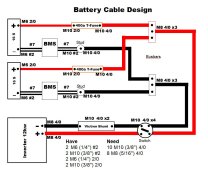MrM1
I'm Here, But I'm Not All There
So I'm Sitting here today laying out the cable design from my battery banks to the Inverter. Putting it all on paper helps me visualized how I will set it all up, and how many lugs I will need, what sizes, and what size cables, etc.
But Boy! ... This seems like a boat load of connections. Is this Typical? Is this going to be a problem for resistance etc making up all these little short cable? I have a 10 ton (?) Hydraulic press crimper for making the cold welds to the lugs that does a good joy and I enjoy using. So I am not concerned about that, but is this many connections typical?
Note: the #7 wire is out of my control as it is fixed to the BMS but is double and is only 5 inches on each side. The 2/0 will be about 12 inches long to the fuse. Everything else will be 4/0
What Could I do differently?

But Boy! ... This seems like a boat load of connections. Is this Typical? Is this going to be a problem for resistance etc making up all these little short cable? I have a 10 ton (?) Hydraulic press crimper for making the cold welds to the lugs that does a good joy and I enjoy using. So I am not concerned about that, but is this many connections typical?
Note: the #7 wire is out of my control as it is fixed to the BMS but is double and is only 5 inches on each side. The 2/0 will be about 12 inches long to the fuse. Everything else will be 4/0
What Could I do differently?



